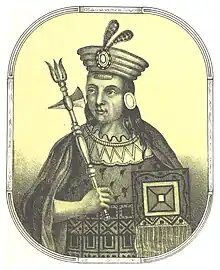| Amaru Topa Yupanqui | |
|---|---|
 Amaru Yupanqui, from Recuerdos de la Monarquia Peruana, by Justo Sahuaraura | |
| Co-ruler of the Inca Empire | |
| Reign | 1450 |
| Predecessor | Pachacuti |
| Successor | Tupac Yupanqui |
| Born | Unknown Cusco |
| Died | Unknown Cusco |
| Spouse | Chimpu Ocllo |
| Father | Pachacuti |
| Mother | Mama Anarwaki |
Amaru Topa Inca,[1][2][3] also known as Amaru Inca Yupanqui,[4] (Quechua: Amaru Tupaq Inka) was an Inca prince and co-ruler of the Hanan dynasty, who reigned around 1450.[5] He was the son of Pachacuti and Mama Anawarki. Around 1450, Pachacuti decided to name him his co-ruler and successor.[1][6][2][5][7] His reign lasted between five[8] and ten years.[9]
Co-reign
He chose the palace of Hatuncancha, in Cuzco, as his residence, and married Curi Ocllo, also called Chimpu Ocllo. Although he was skilled in the administration of the state, he could not familiarize himself with his military tasks. This became evident when a revolt of the Colla broke out around lake Titicaca, while Pachacuti was campaigning in the Amazon rainforest. At first, Pachacuti put down the rebellion himself. However, following his return to Cusco, the Colla revolted again. This time, Amaru, as co-ruler, led the army, accompanied by his two brothers.[3] The Inca armies were victorious, but all the decisions of Amaru Yupanqui, if he would not have been assisted by his brothers, would have been disastrous. Due to the lack of military talent found in the joint prince, Pachacuti changed his decision and instead, with the support of the nobility, who disliked Amaru,[10] decided to name another one of his sons, Tupac Yupanqui, who in turn had a reputation as a talented warrior, as his co-ruler and successor.[1][11][12] Mariano Babtista Gumucio believes that Amaru was not forced to abdicate, and that he succeeded to his father in 1478, before quickly being overthrown by his brother Tupac Yupanqui.[13]
On the other hand, the French historian Henri Favre, rejecting the idea of a "co-government", writes that Tupac Yupanqui, with the support of the army, forced his father to abdicate, and to name him successor instead of Amaru Topa Inca.[6]
Death
The Spanish chronicles last mention him when his brother, now sole ruler of the Inca Empire, was on a campaign in Chile.
Inca Yupanqui
Inca Garcilaso de la Vega mentions an Inca Yupanqui, an Inca emperor whose reign took place between those of Pachacuti and Tupac Yupanqui, and who was the father of the latter; this theory is supported by Peruvian historian Julio Rolando Villanueva Sotomayor.[14] Garcilaso writes that most Spanish chroniclers confused the names of the sovereigns, and that the Inca Yupanqui, present in the names of Pachacuti and Tupac (Pachacuti Inca Yupanqui, Tupac Inca Yupanqui), is a separate person.[15] Pedro Cieza de León also mentions an Inca Yupanqui, but he is referring to Pachacuti.[12] Most chroniclers acknowledge the existence of Amaru, but write that he is only co-sovereign with his father, and that Tupac succeeds the latter.[16][17][3] María Rostworowski indicates that Garcilaso de la Vega avoids mentioning the Inca diarchy, out of fear that this would make his chronicle less comprehensible to the European reader, who could deduce that Tupac Yupanqui is a usurper.[8]
References
- 1 2 3 Métraux, Alfred. Les Incas. Éditions du Seuil. p. 73.
- 1 2 Rostworowski, María (2008). Le Grand Inca Pachacútec Inca Yupanqui (in French). Translated by Duran, Simon. Tallandier. p. 211. ISBN 978-2-84734-462-2.
- 1 2 3 de Gamboa, Pedro Sarmiento. History of the Incas. Translated by Markham, Clements. Cambridge: Parentheses Publications Peruvian Series. pp. 106–108.
- ↑ Valcárcel, Luis Eduardo. Del ayllu al imperio. p. 138.
- 1 2 Del Busto Duthruburu, José Antonio (2000). Una Cronología approximate del Tahuantinsuyo [An approximate chronology of Tanhuantinsuyo] (in Spanish). Lima: Pontifical Catholic University of Peru. p. 18. ISBN 9789972423505.
- 1 2 Favre, Henri (2020). Les Incas. Presses Universitaires de France. p. 22. ISBN 978-2-7154-0360-4.
- ↑ Mannion, Sean (May 31, 2014). "Las sucesiones en el imperio de los incas". Hispanic American Historical Review.
- 1 2 Rostworowski, María (2008). Le Grand Inca Pachacútec Inca Yupanqui (in French). Translated by Duran, Simon. Tallandier. ISBN 978-2-84734-462-2.
- ↑ Martinengui Suárez, Elías (1980). El imperio de los Incas: Causas de su destrucción. Big Print. p. 84.
- ↑ Temoche Cortez, Particia (2010). Breve historia de los incas. Ediciones Nowtilus. p. 138. ISBN 9788497634434.
- ↑ Rostworowski, María (2008). Le Grand Inca Pachacútec Inca Yupanqui. Paris: Tallandier. pp. 152–153. ISBN 978-2-84734-462-2.
- 1 2 de León, Pedro Cieza. El Señorio de los Incas (in Spanish).
- ↑ Gumucio, Mariano Babtista (1981). Historia de Bolivia: para lectores de 9 a 90 años. Empressa Editora.
- ↑ Julio R. Villanueva Sotomayor. Pachacútec El Gran Organizador del Tahuantinsuyu (in Spanish).
- ↑ de la Vega, Garcilaso. Royal Commentaries of the Incas and General History of Peru (in Spanish). Translated by Livemore, Harold V. University of Texas Press.
- ↑ de las Casas, Bartolomé. Historia de las Indias (in Spanish).
- ↑ Pachacuti Yamqui Salcamayhua, Santa Cruz. Relación de las antigüedades deste Reyno del Perú (in Spanish).